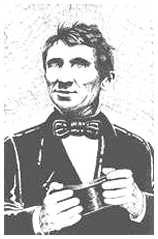

Charles Goodyear
Born: December 29, 1800
Place: New Haven, Connecticut
Died: July 1, 1860
Place: New York, New York

|
|
Illustration courtesy of Mack White |
Charles Goodyear was born in New Haven, Connecticut on December 29, 1800. He had little schooling, and once he was past childhood, he went to work with his father in a hardware business. The business was not successful, so Goodyear began experimenting with a substance called rubber. The raw rubber of this period was a gummy material bled from trees in Brazil. It interested many people because of its natural property of being waterproof and its ability to be stretched and formed. But it was also not a very practical substance, since it became brittle when cold and gummy when warm. Several entrepreneurs had attempted to use rubber in the manufacture of their products, but they were unsuccessful because of the substance's changing properties. Goodyear's idea was that if he could make the product more stable, it could become a successful product. He experimented with adding other materials and chemicals into rubber, but he continued to run into problems. No matter what he added, the product was too gummy and would not keep its shape in hot weather, and it would not maintain its elasticity in cold temperatures.
Many of those people who had seen an early promise in the use of rubber were beginning to think the product was not ever going to be useful. Many lost substantial sums of money in their attempts to use rubber in their manufactured products. Charles Goodyear himself was almost penniless, but he still believed there was a way to use the substance. He made some progress using additives and mixing processes, working with nitric acid, magnesium, and quicklime. For all his mixing and boiling, however, he had not hit upon the right solution. By 1839, he was using sulphur in his experiments. In one of the most celebrated "accidents" in scientific history, a patch of his sulphur and rubber gum mixture landed upon a hot stove, and when Goodyear scraped it off the stove, his eyes lit up. This heated substance had been transformed into a dry elastic material. Goodyear spent years afterwards refining his processes, and he secured his first patent in 1844. The heat process that transforms gummy rubber into a useable rubber is now known as vulcanization.
Charles Goodyear spent most of his life with little or no money. His patent rights were continually infringed upon, and when he died in 1860, he was deep in debt. But his experiments and discoveries proved him right in his belief that rubber could be a widely successful product. Charles Goodyear takes his place in history, however, as the man who revolutionized the rubber industry.
|




